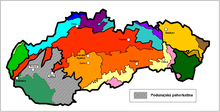Danubian Hills
48.2518.25Coordinates: 48° 15′ 0″ N, 18° 15′ 0″ E
The Danube Hills (Slovak Podunajská pahorkatina) is the northeastern, more mountainous part of the Danube lowlands in Slovakia.
The area is located between the Danubian Plain and the Danube in the south, the Little Carpathians in the west and the rest of the Western Carpathians in the north and east. The border with the Danube plain runs roughly along the line Bratislava - Senec - Sereď - Nové Zámky - Patince.
The soil consists of different types of rock (clay, gravel, sands) covered by quaternary sediments such as loess and very fertile soils (black and brown soils).
The most important cities are Trnava, Topoľčany, Nitra, Levice, Dudince and Štúrovo.
The Danube Hills are divided by the rivers Váh, Nitra, Žitava, Hron and Ipeľ into the following 11 geomorphological parts (divided from west to east):
- Trnavská pahorkatina (Tyrnau Hills)
- Dolnovážska niva (Lower scale level)
- Nitrianska pahorkatina (Neutra Hills)
- Nitrianska niva (Neutra's meadow)
- Žitavská pahorkatina (Žitava Hills)
- Žitavská niva (Žitava meadow)
- Hronská pahorkatina (Gran Hills)
- Hronská niva (Gran field)
- Čenkovská niva (Čenkov corridor)
- Ipeľská pahorkatina (Eipel Hills)
- Ipeľská niva (Eipel meadow)
The mentioned fields have rich underground water reservoirs, other water reservoirs also exist near the town of Dudince.
There are a number of small nature reserves in the area. For example, the marshes have been placed under protection in the Paríž moors (Parížske močiare). In addition, there are also different types of sand-grass or forest plains such as Čenkovská step or Chotínske piesky, as well as many protected residual or still original oak forests (near Dubník or Vŕšok).

Podunajská pahorkatina within the Geomorphological Classification of Slovakia
Search within the encyclopedia